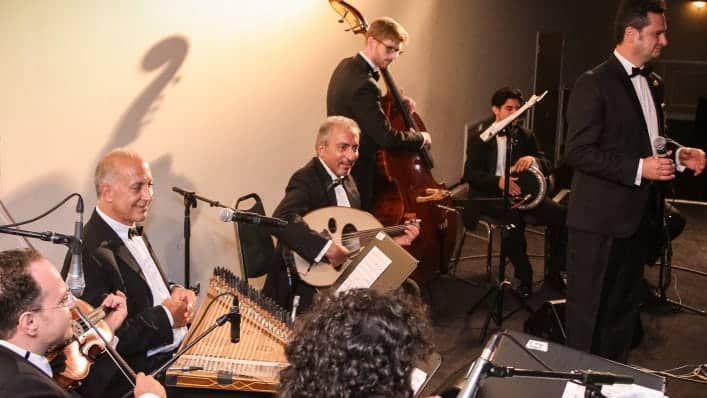The strings hold a quiet rhythm, and the flute lifts in a long rippling call. The melody line carries clear and strong, Plucked strings take it up, and the music builds, fast and soaring. Sharing music can feel like an all-night conversation, like laughing aloud with a friend, like dancing — it’s an exhilaration.
There’s a word for that feeling. It’s the ecstasy musicians feel as they play. In Arabic, it’s tarab, says Michael Ibrahim, founder and director of the National Arab Orchestra.
The NAO’s Takht ensemble will perform at Williams College on Monday, Oct. 21, with strings, wind and rhythm.
“The oud is the grandfather of the guitar,” Ibrahim explained. “The qanum is like a harp. We have a double bass, a percussionist on the riqq, a violinist and the ney, the Arab reed flute.”

The National Arab Orchestra's Takht Ensemble will perform at Williams College. Photo courtesy of Michael Ibrahim and the artists.
The orchestra started 10 years ago, he said by phone from Michigan as he headed home. He began with an ensemble at University of Michigan in Ann Arbor.
He and his musicians have now performed from Washington D.C. to Atlanta to San Antonion, Texas, and this fall they will perform their first international concert, in Saudi Arabia, celebrating women vocalists.
His original ensemble has grown into a larger orchestra, a community choir and a chamber group, and it has transformed the world around it.
Ibrahim and his musicians work with local schools and mentor musicians.
He lives near Dearborn, Mich., and a large Arab-American community.
“They have the highest concentration of Arabs outside the Middle East,” he said.
He remembers coming into Fordson High School in Dearborn with his music. The school had had a large choral program, he said, but it was dying out.
“After our first run, the numbers started to explode,” he said. “Three years later they had 300 students in the program and a roster of classes.”
They sent choirs to festivals and students to music schools. And the state of Michigan is changing now to include world music in its lexicon.
He has also worked with students in Chelsea, Mich., a small town and not a diverse one. They worked with students at Fordson, got to know the music together, visited the Arab American Museum in Dearborn. They’re friends now, he said. They meet up on their own.
He has watched many classes over the years, as kids who are not familiar with the music warm up to it and share their excitement as they get ready to perform. And it is important to him to share the music.
“I’m probably one of only two Arabs in the ensemble,” Ibrahim said, laughing. “We’re a very varied group. We take care of the idea of diversity and opening this up to everyone. If you want people to know who you are, you have to invite people to your home.”
Now his chamber group will travel to the Berkshires.
A takht ensemble was a primary form of music group in Arabic music before World War I, Ibrahim explained. The word takht means a bed or platform, because the instruments create a platform of sound for the singer.
At Williams, they will perform Arab classical music from the early 1900s to the 1960s and 1970s, and they will talk about the music and the culture. ‘Arab’ countries cover a vast and diverse area of land, he said, with many landscapes and cultures, and in the U.S. he feels those distinctions are often washed over.
This concert will offer music from Lebanon and from Egypt, instrumental pieces from the Ottoman empire, call and response music, songs. It will come from many cultures and influences, and it will share a central source of joy.
Tarab is a powerful feeling, he said. Traditionally, for people in the diaspora, it can have a sense of memory, a connection to home and warm times in the past.
In the original tarab, the listeners feel the power of an improvisation, the flow of the music, the modes of the melody. They feel involved in the music, and musicians feel their intensity, and together they build that state of elation.
Improvisation can heighten the feeling. It can come as a solo, Ibrahim said, or as ornamentation to the music.
“Everyone plays loosely around an idea,” he said.
That fluid movement may sound similar to jazz, but Arabic music does not play with chords and harmonies in the way Western music does.
“The best way to think about it,” he said, “is that Western music is vertical. It has layers … chord progressions. Arabic music is horizontal. It has the melody line, and it just goes.”
Several instruments may play the melody together, or one may pick up the melody and take off with it and hand it on to another.
The melody may move between melodic modes, maqamat, each with its own pitch and scale. They influence the notes and the shape of the melody, Ibrahim said, and each one has its own traditions and it’s own tunings.
Maqamat are like Western scales in a way, said Corinna Campbell, professor or music at Williams, but they shape sound in different ways, as Arabic percussion has its own rhythms and syncopations.
The ensemble together creates intense moments of nuance and grace, she said.
“That’s part of the pleasure of tarab,” she said, “… in these moments when the elements and the musicians are working together.”
In that room, when the music moves between the players and the listeners and builds into ecstasy, it becomes something spiritual and profound.

The National Arab Orchestra's Takht Ensemble will perform at Williams College. Photo courtesy of Michael Ibrahim and the artists.
If you go …
What: National Arab Orchestra Takht Ensemble performs in the Ernest Brown World Music Series
Where: Brooks Rogers Recital Hall
When: 7:30 p.m. Monday, Oct. 21
Admission: Free
Information: music.williams.edu

